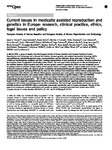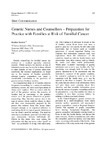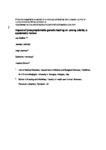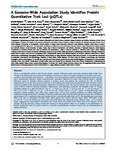Current issues in medically assisted reproduction and genetics in Europe: research, clinical practice, ethics, legal issues and policy
| dc.contributor.author | Harper, JC | |
| dc.contributor.author | Geraedts, J | |
| dc.contributor.author | Borry, P | |
| dc.contributor.author | Cornel, MC | |
| dc.contributor.author | Dondorp, W | |
| dc.contributor.author | Gianaroli, L | |
| dc.contributor.author | Harton, G | |
| dc.contributor.author | Milachich, T | |
| dc.contributor.author | Kääriäinen, H | |
| dc.contributor.author | Liebaers, I | |
| dc.contributor.author | Morris, M | |
| dc.contributor.author | Sequeiros, J | |
| dc.contributor.author | Sermon, K | |
| dc.contributor.author | Shenfield, F | |
| dc.contributor.author | Skirton, Heather | |
| dc.contributor.author | Soini, S | |
| dc.contributor.author | Spits, C | |
| dc.contributor.author | Veiga, A | |
| dc.contributor.author | Vermeesch, JR | |
| dc.contributor.author | Viville, S | |
| dc.contributor.author | de Wert, G | |
| dc.contributor.author | Macek, M | |
| dc.date.accessioned | 2016-09-29T11:20:20Z | |
| dc.date.available | 2016-09-29T11:20:20Z | |
| dc.date.issued | 2013-11 | |
| dc.identifier.issn | 1018-4813 | |
| dc.identifier.issn | 1476-5438 | |
| dc.identifier.uri | http://hdl.handle.net/10026.1/5506 | |
| dc.description.abstract |
In March 2005, a group of experts from the European Society of Human Genetics and European Society of Human Reproduction and Embryology met to discuss the interface between genetics and assisted reproductive technology (ART), and published an extended background paper, recommendations and two Editorials. Seven years later, in March 2012, a follow-up interdisciplinary workshop was held, involving representatives of both professional societies, including experts from the European Union Eurogentest2 Coordination Action Project. The main goal of this meeting was to discuss developments at the interface between clinical genetics and ARTs. As more genetic causes of reproductive failure are now recognised and an increasing number of patients undergo testing of their genome before conception, either in regular health care or in the context of direct-to-consumer testing, the need for genetic counselling and preimplantation genetic diagnosis (PGD) may increase. Preimplantation genetic screening (PGS) thus far does not have evidence from randomised clinical trials to substantiate that the technique is both effective and efficient. Whole-genome sequencing may create greater challenges both in the technological and interpretational domains, and requires further reflection about the ethics of genetic testing in ART and PGD/PGS. Diagnostic laboratories should be reporting their results according to internationally accepted accreditation standards (International Standards Organisation - ISO 15189). Further studies are needed in order to address issues related to the impact of ART on epigenetic reprogramming of the early embryo. The legal landscape regarding assisted reproduction is evolving but still remains very heterogeneous and often contradictory. The lack of legal harmonisation and uneven access to infertility treatment and PGD/PGS fosters considerable cross-border reproductive care in Europe and beyond. The aim of this paper is to complement previous publications and provide an update of selected topics that have evolved since 2005. | |
| dc.format.extent | S1-S21 | |
| dc.format.medium | ||
| dc.language | en | |
| dc.language.iso | eng | |
| dc.publisher | Springer Science and Business Media LLC | |
| dc.subject | Animals | |
| dc.subject | Congenital Abnormalities | |
| dc.subject | Disease Models, Animal | |
| dc.subject | Embryonic Stem Cells | |
| dc.subject | Epigenesis, Genetic | |
| dc.subject | Europe | |
| dc.subject | Female | |
| dc.subject | Fertilization in Vitro | |
| dc.subject | Genetic Counseling | |
| dc.subject | Genetic Testing | |
| dc.subject | Genetic Variation | |
| dc.subject | Genetics, Medical | |
| dc.subject | Guidelines as Topic | |
| dc.subject | Humans | |
| dc.subject | Infertility | |
| dc.subject | Male | |
| dc.subject | Medical Tourism | |
| dc.subject | Policy | |
| dc.subject | Pregnancy | |
| dc.subject | Preimplantation Diagnosis | |
| dc.subject | Regenerative Medicine | |
| dc.subject | Reproduction | |
| dc.subject | Reproductive Techniques, Assisted | |
| dc.subject | Societies, Scientific | |
| dc.title | Current issues in medically assisted reproduction and genetics in Europe: research, clinical practice, ethics, legal issues and policy | |
| dc.type | journal-article | |
| dc.type | Journal Article | |
| dc.type | Research Support, Non-U.S. Gov't | |
| plymouth.author-url | https://www.webofscience.com/api/gateway?GWVersion=2&SrcApp=PARTNER_APP&SrcAuth=LinksAMR&KeyUT=WOS:000327440600001&DestLinkType=FullRecord&DestApp=ALL_WOS&UsrCustomerID=11bb513d99f797142bcfeffcc58ea008 | |
| plymouth.issue | S2 | |
| plymouth.volume | 21 | |
| plymouth.publication-status | Published | |
| plymouth.journal | European Journal of Human Genetics | |
| dc.identifier.doi | 10.1038/ejhg.2013.219 | |
| plymouth.organisational-group | /Plymouth | |
| plymouth.organisational-group | /Plymouth/Faculty of Health | |
| dc.publisher.place | England | |
| dc.identifier.eissn | 1476-5438 | |
| dc.rights.embargoperiod | Not known | |
| rioxxterms.versionofrecord | 10.1038/ejhg.2013.219 | |
| rioxxterms.licenseref.uri | http://www.rioxx.net/licenses/all-rights-reserved | |
| rioxxterms.type | Journal Article/Review |





